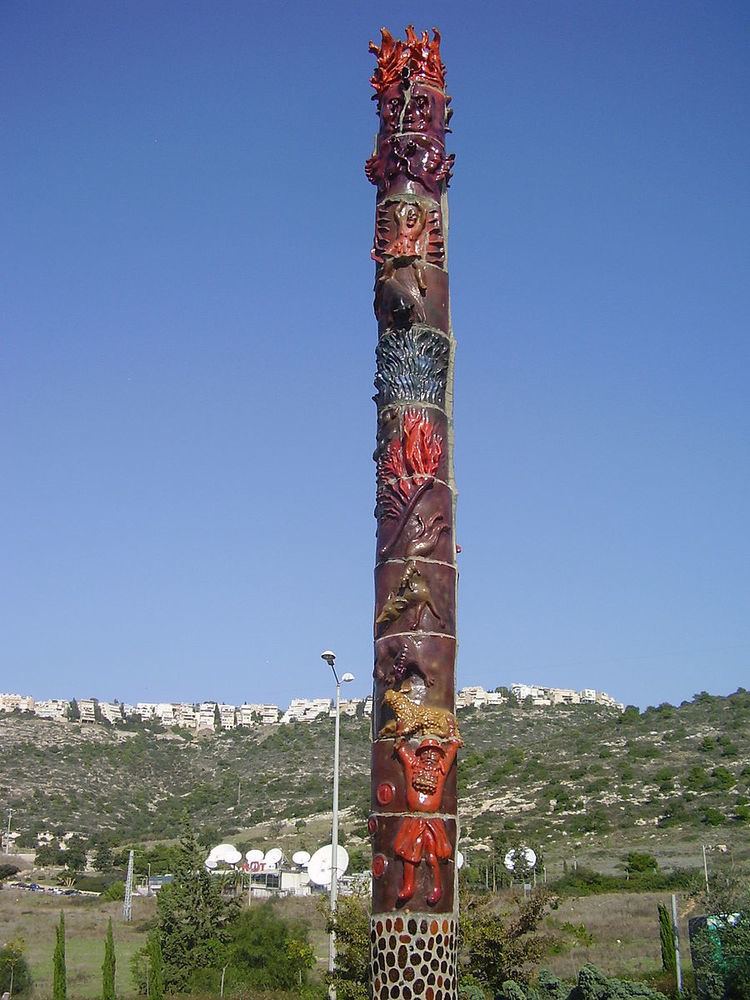 | ||
Chad Gadya or Had Gadya (Aramaic: חַד גַדְיָא chad gadya, "one little goat, or "one kid"; Hebrew: "גדי אחד gedi echad") is a playful cumulative song in Aramaic and Hebrew. It is sung at the end of the Passover Seder, the Jewish ritual feast that marks the beginning of the Jewish holiday of Passover. The melody may have its roots in Medieval German folk music. It first appeared in a Haggadah printed in Prague in 1590, which makes it the most recent inclusion in the traditional Passover seder liturgy.
Contents
The song is popular with children and similar to other cumulative songs: Echad Mi Yodea, ("Who Knows 'One'?) another cumulative song, is also in the Passover Haggadah.
Symbolism
As with any work of verse, Chad Gadya is open to interpretation. According to some modern Jewish commentators, what appears to be a light-hearted song may be symbolic. One interpretation is that Chad Gadya is about the different nations that have conquered the Land of Israel: The kid symbolizes the Jewish people, the cat, Assyria; the dog, Babylon; the stick, Persia; the fire, Macedonia; the water, Roman Empire; the ox, the Saracens; the slaughterer, the Crusaders; the angel of death, the Turks. At the end, God returns to send the Jews back to Israel. The recurring refrain of 'two zuzim' is a reference to the two stone tablets given to Moses on Mount Sinai (or refer to Moses and Aaron). Apparently this interpretation was first widely published in pamphlet published in 1731 in Leipzig by Philip Nicodemus Lebrecht. This interpretation has become quite popular, with many variations of which oppressor is represented by which character in the song.
Though commonly interpreted as an historical allegory of the Jewish people, the song may also represent the journey to self-development. The price of two zuzim, mentioned in every stanza, is (according to the Targum Jonathan to First Samuel 9:8) equal to the half-shekel tax upon every adult Israelite male (in Exodus 30:13); making the price of two zuzim the price of a Jewish soul. In an article first published in the Journal of Jewish Music & Liturgy in 1994, Rabbi Kenneth Brander, the co-author of The Yeshiva University Haggadah, summarized the interpretations of three reknowed rabbis: (1) Rabbi Jacob Emden in 1975, as a list of the pitfalls and perils facing the soul during one's life. (2) Rabbi Jonathan Eybeschuetz (1690-1764) as a very abbreviated history of Israel from the Covenant of the Two Pieces recorded in Genesis 15 (the two zuzim), to slavery in Egypt (the cat), the staff of Moses (the stick) and ending with the Roman conqueror Titus (the Angel of Death). And (3) from Rabbi Moses Sofer, the Hatim Sofer (1762-1839), in which the song described the Passover ritual in the Temple of Jerusalem - the goat purchased for the Paschal sacrifice, according to the Talmud dreaming of a cat is a premonition of singing such as occurs in the seder, the Talmud also relates that dogs bark after midnight which is the time limit for the seder, the priest who led the cleaning of the altar on Passover morning would use water to wash his hands, many people at the Temple that day would bring oxen as sacrifices, the Angel of Death is the Roman Empire that destroyed the Second Temple, etc.
Language
Descriptions of Chad Gadya being "entirely in Aramaic" are in error; the song is mix of Aramaic and Hebrew and indicates that the composer's grasp of Aramaic was limited. For example, the song begins with ḥad gadya, which is Aramaic, instead of the Hebrew form gədi ʾeḥad, and for the cat the Aramaic shunra instead of the Hebrew ḥatul and for the dog the Aramaic kalba instead of the Hebrew kelev, etc., but, towards the end of the song, we find the slaughterer is the Hebrew ha-shoḥet instead of the Aramaic nakhosa and the Angel of Death is the Hebrew malʾakh ha-mavet instead of the Aramaic malʾach mota and, finally, "the Holy One, blessed be He" is the Hebrew ha-qadosh barukh hu whereas the Aramaic would be qudsha bərikh hu. Moreover, the Aramaic grammar is sloppy, for example. "then came the [masculine form] cat and [feminine form] ate". The suggestion that the song was couched in Aramaic to conceal its meaning from non-Jews is also in error, since its first publication included a full German translation.
Versions of the song exist in Ladino (Un cavritico), Judaeo-Italian and Judaeo-Arabic.
Variations
The words "dizabin abah" (ִדְּזַבִּין אַבָּא) in the second line of the song literally mean "which father sold", rather than "which father bought". The Aramaic for "which father bought" is "dizvan abah" (דִּזְבַן אַבָּא), and some Haggadot have that as the text.
